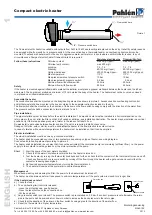
26 • Residen al Standard Gas Water Heater Use and Care Guide
TR
OUBLE
SHOO
TING
26 • Residen al Standard Gas Water Heater Use and Care Guide
TROUBLESHOOTING
plumbing system can make it appear
that the water heater is producing
li le to no hot water. In this case, the
burner will be on all or almost all the
me, yet you will have very li le hot
water. Locate and repair the leak.
Sediment or Lime in Tank.
With an ex-
is ng water heater, if you have some
hot water but not as much as you’re
used to, there may be a build up of
sediment or lime on the bo om of the
tank. Sediment or lime build up can
reduce the effi
ciency of your water
heater. Heavy deposits can damage
the water heater. See the Mainte-
nance sec on for steps on draining
and fl ushing the water heater.
Temperature Too High
Adjust the thermostat on the water
heater to a lower se ng. Install or
adjust Thermosta c Mixing Valves
for each point-of-use (see the valve
manufacturer’s instruc ons).
Low Water Pressure
Check both the cold and hot water
at a sink to determine if the lower
pressure is only on the hot water side.
If both hot and cold faucets have low
pressure, call your local water u lity.
If the low pressure is only on the hot
water side, the primary causes are:
•
Melted heat traps or dip tube. Sol-
dering copper pipes while they are
connected to the water heater can
melt the heat traps inside the hot
and cold water connec ons or the
dip tube (cold water side). Melted
heat traps or a melted dip tube
can restrict the fl ow of hot water.
If that’s the case, replace the heat
traps or dip tube.
•
Par ally closed supply valve. Open
the water heater’s supply valve fully.
Drips from T&P Relief
Valve Discharge Pipe
A small amount of water dripping
from the Temperature and Pressure
(T&P) Relief Valve usually means the
home’s water pressure is too high
and/or you need a Thermal Expan-
sion Tank. See Step 1 in the Installa-
on sec on of this manual for more
informa on.
A large amount of hot water coming
from the T&P discharge pipe may be
due to the tank overhea ng. If the
T&P relief valve is discharging large
amounts of very hot water, turn the
gas supply valve off and call a quali-
fi ed person.
WARNING! Do not cap or plug the
T&P Relief Valve or discharge pipe,
and do not operate the water heater
without a func oning T&P Relief
Valve—this could cause an explosion.
Water Pressure too High.
High water
pressure can cause the T&P Relief
Valve to drip. Install a Pressure Re-
ducing Valve (PRV) on the main cold
water supply line. Adjust the PRV to
between 50 and 60 psi.
Thermal Expansion Tank.
Install a
Thermal Expansion Tank. If a Thermal
Expansion Tank is already installed
and the T&P Relief Valve discharge
pipe drips, the home’s water pressure
may be too high or the Thermal Ex-
pansion Tank may be defec ve. Refer
to the instruc ons that came with
the Thermal Expansion Tank for more
informa on.
Debris.
In rare cases, debris can s ck
inside the T&P Relief Valve preven ng
the valve from sealing fully. In that
case, the T&P Relief Valve discharge
pipe will drip. You may be able to
clear debris from the T&P Relief Valve
by manually opera ng the valve,
allowing small quan es of water to
fl ush out the debris. See the label on
the T&P Relief Valve for instruc ons.
WARNING! When manually
opera ng the temperature-pressure
relief valve, make sure that no one is
in front of or around the discharge
outlet. The water may be extremely
hot and could cause severe burns.
Also ensure that the water discharge
will not cause property damage.
If the water pressure is between 50
and 60 psi, a Thermal Expansion Tank
is installed and properly pressurized,
and the valve has been cleared of any
debris, and it s ll drips, the valve may
be broken—have a qualifi ed person
replace the T&P Relief Valve.
Water Odor
Harmless bacteria normally present in
tap water can mul ply in water heat-
ers and give off a “ro en egg” smell.
Although elimina ng the bacteria that
causes “smelly water” is the only sure
treatment, in some cases, the stan-
dard anode rod that came with your
water heater can be replaced with a
special zinc anode rod which may help
reduce or eliminate the odor. Contact
a qualifi ed person.
NOTICE:
To protect the tank, an anode
rod must be installed in the water
heater at all mes or the warranty is
void.
In cases where the “ro en egg” smell
is very strong, you could increase the
tank temperature to 140°F in order to
reduce bacterial growth in the tank.
WARNING! Because higher
temperatures increase the risk of
scalding, if you set the thermostat(s)
higher than 120°F, Thermosta c
Mixing Valves at each point-of-use
are par cularly important.
Summary of Contents for GSL050-40
Page 31: ...Residen al Standard Gas Water Heater Use and Care Guide 31 NOTES NOTES ...
Page 32: ...32 Residen al Standard Gas Water Heater Use and Care Guide NOTES NOTES ...
Page 33: ...Residen al Standard Gas Water Heater Use and Care Guide 33 NOTES NOTES ...
Page 34: ...34 Residen al Standard Gas Water Heater Use and Care Guide NOTES NOTES ...











































